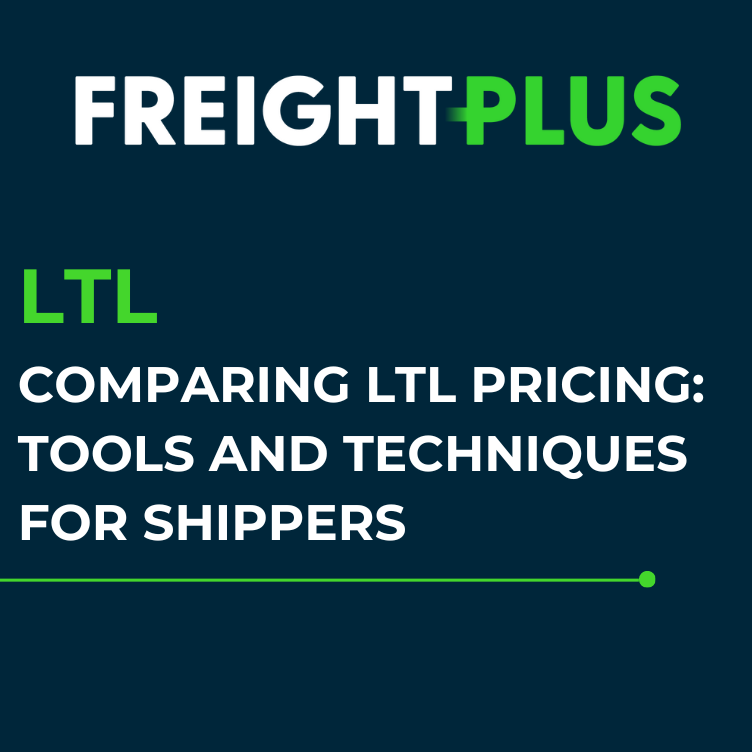One common question we hear at FreightPlus is, “What kind of tools are available to shippers to compare LTL base rates and discounts?” It is a simple question that doesn’t come with a straightforward answer. Like many things LTL, comparing rates is not as simple as comparing apples to apples, and therefore there isn’t a one stop shop solution.
Rate Modeling
Much like carriers, shippers / 3PLs need to be able to model the inputs for a shipment. You need to have a firm grasp on the end-to-end shipment, and full visibility to things like linehaul rates, freight type, fuel surcharges and accessorial charges. It’s additionally crucial to understand what’s happening along the way. For example, you need to understand aspects of the freight like average weight, average pickup times and even considerations like the California compliance fee, which is something many carriers charge for.
As a starting point, shippers need to have access to the information that makes up the base rates and then model that information from there.
- Freight type
- Fuel surcharges
- Accessorial charges
- Linehaul rates
Technical Tools
Now that we have access to the basic information, what technical tools are available to compare base rates? It’s important to note that while there are resources available out there, there is no one solution and each come with their own set of pros and cons.
Online Freight Quote Platforms:
Platforms like Freightquote, uShip, and Freightos provide online tools that allow shippers to input shipment details and receive instant quotes from multiple carriers. These platforms often display base rates and any available discounts, enabling shippers to compare options easily.
Pros:
- Quick and easy access to instant quotes.
- User-friendly interfaces.
- Can be suitable for small to medium-sized shippers.
Cons:
- Limited customization options.
- May not provide in-depth analytics or historical data.
Transportation Management Systems (TMS):
TMS solutions are comprehensive software platforms that handle various aspects of transportation management. They often include features for comparing rates, optimizing routes, and managing carrier relationships. TMS can integrate with carriers’ systems to provide real-time rate information.
Pros:
- Comprehensive solution for end-to-end transportation management.
- Integration with carriers and other systems.
- Offers advanced features beyond rate comparison.
Cons:
- Higher upfront costs and potential complexity.
- May require training for optimal utilization.
Rate Shopping Software:
Rate shopping tools are designed specifically for comparing shipping rates. These tools aggregate rate data from different carriers, allowing shippers to compare base rates, discounts, and additional charges side by side. They may also offer analytics to optimize carrier selection based on historical performance.
Pros:
- Aggregates rates from multiple carriers for easy comparison.
- Can provide analytics for optimizing carrier selection.
Cons:
- Costs associated with subscription or usage.
- Effectiveness may vary based on the quality of carrier integrations.
API Integrations with Carriers:
Shippers can integrate their systems with carriers’ APIs to get real-time quotes and rates. This direct integration allows for accurate and up-to-date information on base rates and any applicable discounts.
Pros:
- Real-time access to carrier rates.
- Direct integration for accurate information.
- Batch rating
Cons:
- Development and maintenance costs for integration.
- Dependency on carrier API availability and reliability.
- Account must already be setup with pricing coding
Data Analytics Platforms:
Advanced data analytics tools can help shippers analyze historical shipping data, track trends, and identify opportunities for cost savings. These platforms may offer insights into carrier performance, helping shippers negotiate better rates and discounts.
Pros:
- In-depth analysis of historical shipping data.
- Identifies trends and opportunities for cost savings.
Cons:
- May require data expertise for effective use.
- Initial setup and learning curve.
Rate Management Software:
Rate management tools assist shippers in organizing and managing their negotiated rates with carriers. These systems often include features for comparing rates, tracking changes, and ensuring that the agreed-upon discounts are applied accurately.
Pros:
- Organizes and manages negotiated rates.
- Ensures accurate application of discounts.
Cons:
- May lack advanced features for broader transportation management.
- Initial setup complexity.
Benchmarking Tools:
Benchmarking tools compare a shipper’s rates against industry benchmarks, helping them assess the competitiveness of their rates and negotiate better terms with carriers.
Pros:
- Compares rates against industry benchmarks.
- Supports negotiation for better terms.
Cons:
- Limited to rate benchmarking and may lack broader functionality.
- May not be suitable for all shippers, especially smaller ones.
While there are some off the shelf tools to compare rates, the reality is there are very few off the shelf solutions that can do it all. We commonly see more in house solutions tied to the TMS – some made in house, some purchased, but most often it’s a combination of multiple solutions.
The risk in LTL is that there isn’t one place to go, but a good starting point is to:
- Access information that makes up your base rates
- Model your rates
- Utilize a TMS
- Leverage LTL transportation pricing and technology like an SMC3
FreightPlus is here to guide you through the complexities of LTL with industry-leading expertise. Contact us today to explore tailored solutions that meet your unique shipping needs.
For Shippers
Are you looking to connect with a sales representative?



